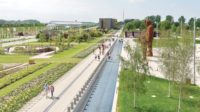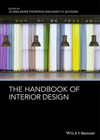At New York’s Center for Architecture, an exhibition of models quietly constructed in Iraq shows 20th-century dreams for the city.
| Image Venturi, Scott Brown and Associates, Inc. |
Venturi, Rauch and Scott Brown, Project for the Competition for a National Mosque of Baghdad, 1982, Baghdad, Iraq. Click the image above to view additional image from City of Mirages: Baghdad, 1952-1982. |
Related Exhibition: In addition to the Baghdad exhibition the Center for Architecture is simultaneously showcasing current work in the greater Middle East. On view through June 23, CHANGE: Architecture and Engineering in the Middle East, 2000-Present, strikes a hopeful note on the Center’s lower level, with glossy, futuristic renderings and photographs. The Center held an open call for built and unbuilt work in the Middle East from the last decade and the resulting 123 projects—designed for roughly 20 Mid-East countries—are meant to be a snapshot of what’s happening now, from Richard Meier’s Rothschild Tower in Tel Aviv to James Carpenter's Israel Museum in Jerusalem to 360 Architecture’s Basrah Sport City in Iraq, both slated for completion in 2013.
Click the image above to view additional images from CHANGE: Architecture and Engineering in the Middle East.
It’s common knowledge that such 20th-century masters as Frank Lloyd Wright, Le Corbusier, Walter Gropius, and Alvar Aalto occasionally worked outside of their home countries. But many who know their work well might be surprised to learn that all four, as well as a number of their contemporaries, designed projects for Iraq. An exhibition at the New York AIA’s Center for Architecture, City of Mirages: Baghdad, 1952-1982, on view through May 5th, introduces this lesser-known work, creating a narrative that places them in historical, political, and artistic context.
The 15 models at the Center represent built and unbuilt work by 11 architects, who were commissioned during the mid-century decades that Baghdad officials were ambitiously creating a modern city. Their hope was that design would shape society in addition to transforming the built environment. “This is a history we don’t know a lot about,” says Rosamond Fletcher, director of exhibitions at the Center, who first heard about the show from a colleague. “The exhibition is historic in scope but relevant,” she says, as Baghdad attempts to rebuild after almost a decade of war.
Making its U.S. debut at the Center, the exhibition was originally organized for the Col•legi d’Arquitectes de Catalunya in Barcelona in 2008. It was a difficult and dangerous undertaking, says curator Pedro Azara, a professor at the Barcelona School of Architecture. Azara researches mythology and architecture and, in 2006, stumbled on the topic of international architects doing work in Baghdad in the mid-20th century. The uneven documentation of such projects and the lack of awareness about their current states of preservation or disrepair sparked his curiosity.
Azara began working with students and professors at the University of Baghdad’s architecture school to build all but one of the models in the show. Fearing reprisal from political factions over creating an exhibition bound for the West, their work was shrouded in secrecy. Students had no idea they were building models for a Spanish exhibition, messages and emails between the show’s organizers were enigmatic, and Azara told almost no one when he traveled to Baghdad.
The models at the Center mostly stand alone, without accompanying photography or drawings, a smart visual trick that allows visitors to imagine how, built and intact, they might have influenced the city. In reality, most of the projects have been victims of war, damaged or destroyed, or they were never built.
A 1957 mosque designed by Walter Gropius, The Architects’ Collaborative, and Hisham A. Munir for the University of Baghdad campus reduces the building type to its dome, which touches the ground at three delicate points. An opera house, designed by Wright from 1957-59 but never built, sits on a hill and is approached by a spiraling road—a move that his Guggenheim Museum, designed earlier but completed in 1959, takes to an extreme.
Other models include a sports arena by Le Corbusier, housing by Robert Venturi, Denise Scott Brown, and John Rauch, and a mosque by Ricardo Bofill commissioned by Saddam Hussein (the dictator held repeated competitions for the mosque for over two decades because he was unhappy with each jury’s winner). In contrast to these projects, a large-scale model of contemporary Baghdad sits in the Center’s double-height atrium. Viewed from above, it gives a sense of the geographical hurdles the city’s seven million people encounter each day, with no public transportation to deliver them to their jobs and a curfew that equates dusk with danger.
“We wanted to try to change the image we had in Spain of Iraq,” says Azara of organizing the exhibition. “We also wanted to show that, while Spain was in the third world under Francisco Franco, Baghdad had been a really open place, with very contemporary art and a nonreligious society.













